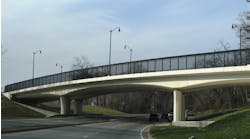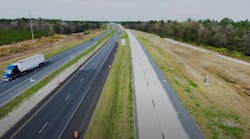The cost to build roads, runways and bridges would increase by an estimated $104.6 billion over the next 20 years if coal fly ash is no longer available as a transportation construction building material, according to a new study by the American Road & Transportation Builders Association's Transportation Development Foundation (ARTBA-TDF).
Fly ash is a byproduct of coal combustion for electricity generation. It is widely used as a supplementary cementitious material in the production of concrete. Fly ash concrete is a mixture of choice for many state and local transportation departments and transportation engineers because of its performance-enhancing and cost-saving benefits.
It also has been praised for its environmental benefits as a "green" building material—putting to use an energy-production byproduct that reduces demand for carbon-intensive portland cement, requires less water in the setting process and would otherwise wind up in a landfill.
Despite its many documented advantages and widespread use, new proposed disposal regulations may limit or eliminate its availability. The ARTBA-TDF study was conducted to forecast the potential economic impacts of the loss of fly ash availability in just one U.S. construction market: transportation infrastructure.
Alison Premo Black, ARTBA senior economist and the report's author, said the excess $5.23 billion annual direct cost includes a $2.5 billion increase in the price of materials and an additional $2.73 billion in pavement and bridge repair work due to the shorter pavement and service life of other portland cement blends.
To put the $5.23 billion figure in perspective, it is almost $2 billion per year more than the federal government currently invests in the Airport Improvement Program and about 13% of the federal government's total annual aid to the states for highway and bridge work.
According to Black: "Without the availability of fly ash, American taxpayers would ultimately bear the burden, either paying more for the same level of transportation improvements, or dealing with the consequences of a scaled-back improvement program."
"The study's findings should be a real eye-opener for members of Congress and other federal policy makers," said Bill Gehrmann, president of Headwaters Resources Inc., whose group commissioned the report. "Without coal ash, concrete will become more expensive, and the environmental footprint of the transportation sector will only increase. There is nothing 'green' or sustainable in such a scenario."
The ARTBA Foundation study also explored how states would have to forego the potential additional benefits and savings derived from using fly ash in new, high-performance concrete pavements. Fly ash is a key component of high-performance concrete pavement designed for a lifespan of 30 to 60 years for concrete roads, compared to the current average of 20 to 25 years.
According to Black's findings, the estimated savings from the increased durability of various fly ash concrete life spans would be:
- $25 billion over 20 years ($1.2 billion per year average) if all concrete roadways were designed with fly ash concrete materials to last 35 years, compared to the current national average of 20 to 25 years;
- $33.5 billion over 20 years ($1.7 billion per year) if all concrete roadway repair and reconstruction work used fly ash concrete with a 40-year life span;
- $51.5 billion over 20 years ($2.6 billion per year) if all concrete roadway repair and reconstruction work used fly ash concrete with a 50-year life span; and
- $65.4 billion over 20 years ($3.2 billion per year) if all concrete roadway repair and reconstruction work used fly ash concrete with a 60-year life span.
The analysis utilized bid tab data from 48 states and Washington, D.C., collected and organized by Oman Systems Inc., in Nashville, Tenn. The same data are used by the Federal Highway Administration (FHWA) to calculate the National Highway Construction Cost Index. It also used transportation construction market data from the U.S. Census Bureau, FHWA's National Bridge Inventory and Highway Performance Monitoring System and conducted extensive surveys and personal interviews with state transportation department officials and fly ash supply company executives to determine state market shares and penetrations.
The report is available in the economics and research section of www.artba.org.


